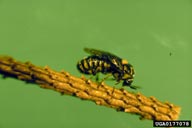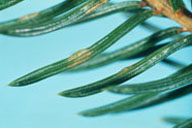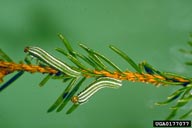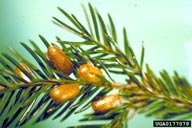European spruce sawfly
Gilpinia hercyniae (Hartig) (Hymenoptera: Diprionidae)
Orientation to pest
The European spruce sawfly, Gilpinia hercyniae (Hartig), is an introduced sawfly from Europe that feeds on spruce (Picea). Currently, this sawfly is found in Canada from the Maritimes west to Manitoba, and on the island of Newfoundland. In the United States, it is present from the northeast to the Great Lake states. White spruce (Picea glauca [Moench] Voss) and other species in the genus are attacked. Adults emerge in spring and lay eggs in slits cut in needles of host trees. Larvae of all ages feed singly; old needles are preferred, but both old and new needles are consumed. Mature larvae spin cocoons in which they pupate. For the overwintering generation, cocoons are formed in the duff below host trees, while non-overwintering cocoons are attached to foliage or twigs. Depending on the location, there may be one to three generations per year. About a decade or so after the detection of this species in North America, outbreaks became widespread and continuous in eastern Canada. In the 1940s, biological control of this species was achieved by introducing a series of European parasitoids and, accidentally, a nuclear polyhedrosis virus. Outbreaks of this species no longer occur in North America due to the combined action of these natural enemies.
Hosts commonly attacked
White spruce (Picea glauca [Moench] Voss) is the preferred host, but red (Picea rubens Sarg.), black (Picea mariana [Mill.] Britton, Sterns & Poggenburg), and Norway (Picea abies [L.] H. Karst.) spruce are attacked.
Distribution
This sawfly is found from the Maritimes west to Manitoba, and on the island of Newfoundland. In the United States, it is present in the northeastern States, west the Great Lakes region.
Images of European spruce sawfly
| Figure 1. Adult of the European spruce sawfly, Gilpinia hercyniae | Figure 2. Eggs (seen as swollen areas, see arrow) inside spruce needles | Figure 3. Larvae of the European spruce sawfly | Figure 4. Cocoons of a non-diapausing generation of the European spruce sawfly |
Important biological control agents related to this pest species
Importations of parasitoids from Europe against the European spruce sawfly were begun after detection of a large outbreak in the Gaspé region of Quebec, and natural enemy introductions were carried out on a massive scale. Millions of sawfly cocoons and eggs were collected in Europe and shipped to Canada where their parasitoids were reared and released. Eventually a rearing program was established in Canada that produced over 800 million parasitoids between 1932 and 1958. Overall some 30 species of parasitoids were identified from Europe and Japan and introduced into North America. At least seven species established, of which the first was Dahlbominus fuscipennis Zett. in Quebec, followed by several species of Exenterus. Biological control was eventually achieved not by parasitoids but by the accidental introduction of a nucleopolyhydrosis virus (Borrelinavirus hercyniae) sometime before 1938. By 1943, G. hercyniae populations were in marked decline with B. hercyniae identified as the most important cause. This virus, together with the introduced parasitoids, caused a widespread reduction of G. hercyniae of 90-95% by 1945. Once outbreaks had ceased G. hercyinae populations were regulated by the combination of B. hercyniae and two introduced parasitoids Drino bohemica (Mesn.) and Exenterus vellicatus Cush. Minor outbreaks continued to occur for some years, on the edge of the species' range and in forests that had been sprayed with DDT to control populations of the spruce budworm (Choristoneura fumiferana Clem.); areas where the pest had temporarily outpaced the expansion of the ranges of the introduced natural enemies or where natural enemies had been killed by pesticide use.
Web links for information on European spruce sawfly
Articles
- Clark, R. C., L. J. Clarke, and K. E. Pardy. 1973. Biological control of the European spruce sawfly in Newfoundland. Bi-monthly Research Notes 29 (1): 2-3.
- Adams, P. H. W. and P. F. Entwistle. 1981. An annotated bibliography of Gilpinia hercyniae (Hartig), European spruce sawfly. Occasional Papers No. 11. Commonwealth Forestry Institute, 58 pp.
- McCugan B. M. and H. C. Coppell. 1962. A review of biological control attempts against insects and weeds in Canada. Part II. Biological control of forest insects, 1910 - 1958. Technical Communication No. 2 Commonwealth Institute of Biological Control, Trinidad. Commonwealth Agriculture Bureaux, Farnahm Royal, Bucks, England, pp. 35-177







